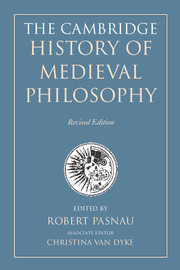Book contents
- Frontmatter
- Contents of Volume 1
- Preface
- List of contributors
- Frontmatter
- Contents of Volume 2
- Introduction
- I Fundamentals
- II Logic and language
- 10 The development of logic in the twelfth century
- 11 Terminist logic
- 12 Nominalist semantics
- 13 Inferences
- 14 Sophismata
- 15 Grammar
- III Natural philosophy
- IV Soul and knowledge
- V Will and desire
- VI Ethics
- VII Political philosophy
- VIII Metaphysics
- IX Theology
- Appendices
- Bibliography of primary sources
- Bibliography of secondary sources
- Index nominum
- Index rerum
- References
12 - Nominalist semantics
from II - Logic and language
Published online by Cambridge University Press: 05 August 2014
- Frontmatter
- Contents of Volume 1
- Preface
- List of contributors
- Frontmatter
- Contents of Volume 2
- Introduction
- I Fundamentals
- II Logic and language
- 10 The development of logic in the twelfth century
- 11 Terminist logic
- 12 Nominalist semantics
- 13 Inferences
- 14 Sophismata
- 15 Grammar
- III Natural philosophy
- IV Soul and knowledge
- V Will and desire
- VI Ethics
- VII Political philosophy
- VIII Metaphysics
- IX Theology
- Appendices
- Bibliography of primary sources
- Bibliography of secondary sources
- Index nominum
- Index rerum
- References
Summary
OCKHAM’S SEMANTIC INNOVATIONS
The most significant development in the history of late medieval philosophy and theology was the emergence of late medieval nominalism, eventually culminating in the quasi-institutional separation of the realist “old way” (via antiqua) and the nominalist “modern way” (via moderna). This chapter will confine itself to analyzing the fundamental changes in semantic theory initiated by William of Ockham, and brought to fruition by John Buridan. In order to be able to see the significance of these conceptual changes against the background of the older theory, the discussion begins with a brief sketch of those common characteristics of the “old semantics” that Ockham abandoned. After presenting Ockham’s main reasons for breaking with the older model and sketching his alternative ideas, the discussion proceeds to a more detailed analysis of Buridan’s radically new approach to constructing semantic theory.
The term ‘realism’ in connection with medieval philosophy is generally used to indicate a metaphysical position concerning universals, namely, the assumption of the existence of some abstract, universal entities expressed by our universal terms, such as ‘man’ or ‘animal.’ But medieval realism as a semantic conception is more than just a theory of universals; it is rather a comprehensive conception of the relationships between language, thought, and reality. The easiest way to introduce the basic ideas of this conception is through the analysis of a simple example. Consider the proposition ‘Every man is an animal.’ When I refer to the sentence enclosed in quotation marks as a proposition, I use the term ‘proposition’ in the medieval sense, meaning the token-inscription between the quotes. But of course this inscription and its significative parts are meaningful to us only because reading it produces some understanding in our minds.
Information
- Type
- Chapter
- Information
- The Cambridge History of Medieval Philosophy , pp. 159 - 172Publisher: Cambridge University PressPrint publication year: 2014
